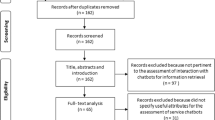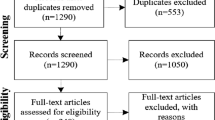Abstract
Advances related to the popularization of the Ambient Intelligence approach imply that new styles of computer–human interaction are being adopted, and, at the same time, the need of supporting activities of collaborative nature appears. In these contexts, the concept of implicit interaction appears. This concept refers to those actions that a computer considers as inputs although the user has not intended to explicitly generate an input. When dealing with implicit interaction, classic concepts about computer–human interaction are not enough, for example, when giving support to awareness. Thus, in this paper we propose a framework for helping software engineers to collect requirements and describe awareness support in systems in which collaborative activities should be supported and in which both implicit and explicit interactions may occur. As these systems may deal with both implicit and explicit interactions, their user interfaces may be of a multimodal nature. The framework includes a categorization of awareness dimensions that extends previous relevant works in the literature, a catalogue of widgets and devices for awareness support, and a technique for carrying out the specifications, which we call awareness cards. We have carried out some validations of our framework, including its application to some cases and some modeling activities with users.

Similar content being viewed by others
References
Antunes P, Herskovic V, Ochoa SF, Pino JA (2014) Reviewing the quality of awareness support in collaborative applications. J Syst Softw 89:146–169
Bravo C, Duque R, Gallardo J (2013) A groupware system to support collaborative programming: design and experiences. J Syst Softw 86(7):1759–1771
Chen H, Finin T, Joshi A (2003) An ontology for context-aware pervasive computing environments. Knowl Eng Rev 18:197–207 (Special Issue on Ontologies for Distributed Sytems)
Collazos C, Guerrero L, Pino J (2003) Knowledge construction awareness. J Stud Cent Learn 1(2):76–86
Dey AK (2001) Understanding and using context. Pers Ubiquit Comput 5(1):4–7
Dourish P, Bellotti V (1992) Awareness and coordination in shared workspaces. In: Proceedings 1992 ACM conference on computer-supported cooperative work
Ellis C, Gibbs S, Rein G (1991) Groupware: some issues and experiences. Commun ACM 34(1):39–58
Gallardo J, Molina AI, Bravo C (2012) A framework for the design of awareness support in collaborative situations of implicit interaction. In: 13th international conference Interacción Persona-Ordenador, INTERACCION’12. ACM international conference proceeding series
Gallardo J, Molina AI, Bravo C, Gallego F (2015) Experiences of use of a multi-domain tool for collaborative software engineering tasks. In Filipe J, Maciaszek L (eds) Evaluation of novel approaches to software engineering, CCIS 551, pp 93–108
Gallego F, Molina AI, Gallardo J, Bravo C (2011) A conceptual framework for modeling awareness mechanisms in collaborative systems. In: Human–computer interaction—INTERACT 2011, LNCS 6949. Springer
Greenberg S, Gutwin C (2016) Implications of we-awareness to the design of distributed groupware tools. Comput Support Coop Work CSCW Int J 25(4–5):279–293
Gross T, Stary C, Totter A (2005) User-centered awareness in computer-supported cooperative work-systems: structured embedding of findings from social sciences. Int J Hum Comput Interact 18(3):323–360
Gutwin C, Greenberg S, Roseman M (1996) Workspace awareness in real-time distributed groupware: framework, widgets, and evaluation. In: People and computers XI (Proceedings of HCI ’96)
Gutwin C, Greenberg S (2002) A descriptive framework of workspace awareness for real-time groupware. CSCW J 11:411–446
Gutwin C, Schneider O, Xiao RB, Brewster S (2011) Chalk sounds: the effects of dynamic synthesized audio on workspace awareness in distributed groupware. In: Proceedings 2011 ACM conference on computer supported cooperative work, CSCW 2011
Hervás R, Bravo J (2011) Towards the ubiquitous visualization: adaptive user-interfaces based on the semantic web. Interact Comput 23(1):40–56
Jourde F, Laurillau Y, Nigay L (2010) COMM notation for specifying collaborative and multimodal interactive systems. In: Proceedings 2nd ACM SIGCHI symposium on engineering interactive computing systems (EICS ’10). ACM, New York, NY, pp 125–134
Ju W, Lee BA, Klemmer SR (2008) Range: exploring implicit interaction through electronic whiteboard design. In: Proceedings 2008 ACM conference on computer supported cooperative work (CSCW ’08). ACM, New York, NY, pp 17–26
Lopez G, Guerrero LA (2017) Awareness supporting technologies used in collaborative systems. In: Proceedings of the 2017 ACM conference on computer supported cooperative work and social computing—CSCW ’17, pp 808–820
López de Ipiña D, Vázquez JI, Abaitua J (2006) A context-aware mobile mash-up for ubiquitous web. In: Proceedings 2nd international workshop UCAmI 2006, pp 19–34
Maeda E, Minami Y (2006) Steps toward ambient intelligence. NIT Tech Rev 4(1):50–55
Mealla S, Väljamäe A, Bosi M, Jordà S (2011) Listening to your brain: implicit interaction in collaborative music performances. In: Proceedings international conference on new interfaces for musical expression (NIME 2011), pp 149–154
Molina AI, Redondo MA, Ortega M (2009) A methodological approach for user interface development of collaborative applications: a case study. Sci Comput Program 74(9):754–776
Molina AI, Gallardo J, Redondo MA, Bravo C (2015) Assessing the awareness mechanisms of a system to support collaborative programming. Dyn Colomb 82(193):212–222
Molina AI, Gallardo J, Navarro CX, Redondo MA (2016) A model-driven approach for the development of CSCL tools that considers pedagogical usability. In: Proceedings of the 1st international workshop on collaborative modelling in MDE (COMMitMDE 2016), pp 45–53
Moody DL (2009) The “physics” of notations: towards a scientific basis for constructing visual notations in software engineering. IEEE Trans Softw Eng 35(6):756–779
Obrist M, Velasco C, Vi C, Ranasinghe N, Israr A, Cheok A, Spence C, Gopalakrishnakone P (2016) Sensing the future of HCI: touch, taste, and smell user interfaces. Interactions 23(5):40–49
Paternò F, Santoro C et al (1998) Formal model for cooperative tasks: Concepts and an application for en-route air traffic control. In: Proceedings 5th international workshop on design, specification, and verification of interactive systems DSV-IS ’98, Abingdon. Springer
Paternò F (2004) ConcurTaskTrees: an engineered notation for task models. In: Diaper D, Stanton NA (eds) The handbook of task analysis for HCI. LEA, Mahwah, NJ, pp 483–501
Reinhardt W (2010). A widget-based dashboard approach for awareness and reflection in online learning communities based on artefact-actor-networks. In: The PLE conference. Retrieved from http://pleconference.citilab.eu
Rittenbruch M (2002) Atmosphere: a framework for contextual awareness. Int J Hum Comput Interact 14(2):159–180
Schmidt A (2000) Implicit computer-human interaction through context. Person Ubiquit Comput 4(2–3):191–199
Shadbolt N (2003) Ambient intelligence. IEEE Intell Syst 18(4):2–3
Tenenberg J, Roth WM, Socha D (2016) From I-awareness to we-awareness in CSCW. Comput Support Coop Work (CSCW) 25(4–5):235–278
Teruel MA, Navarro E, López-Jaquero V, Montero F, González P (2017) A comprehensive framework for modeling requirements of CSCW systems. J Softw Evol Process 29(5):e1858
Vázquez JI, López de Ipiña D, Sedano I (2006) SoaM: a web-powered architecture for designing and deploying pervasive semantic devices. Int J Web Inf Syst 2(3–4):212–224
Acknowledgements
This work has been partially funded by the Secretaría de Estado de Investigación, Desarrollo e Innovación (Government of Spain) in the TIN2015-66731-C2-2-R Project.
Author information
Authors and Affiliations
Corresponding author
Rights and permissions
About this article
Cite this article
Gallardo, J., Bravo, C. & Molina, A.I. A framework for the descriptive specification of awareness support in multimodal user interfaces for collaborative activities. J Multimodal User Interfaces 12, 145–159 (2018). https://doi.org/10.1007/s12193-017-0255-x
Received:
Accepted:
Published:
Issue Date:
DOI: https://doi.org/10.1007/s12193-017-0255-x




